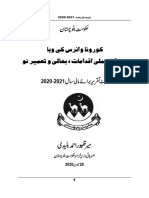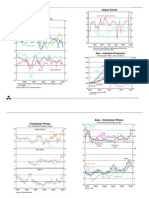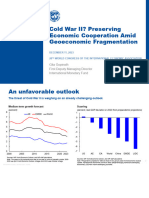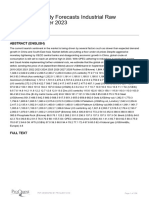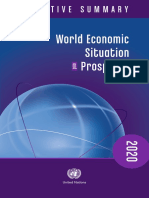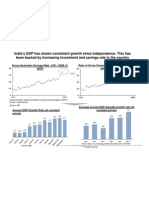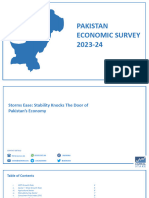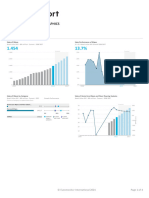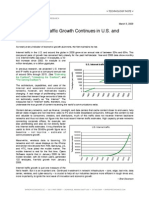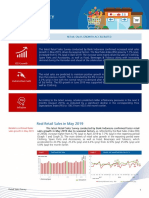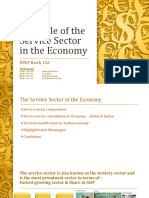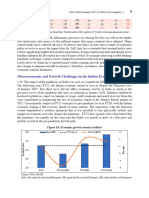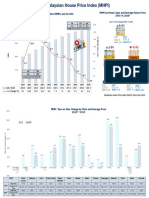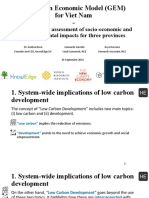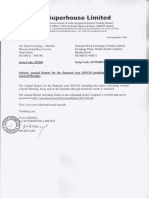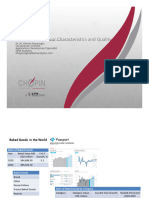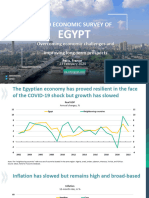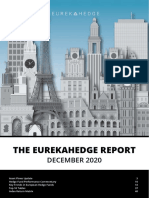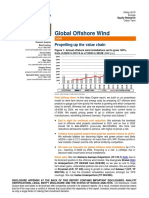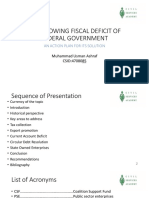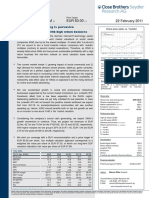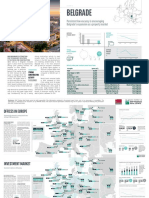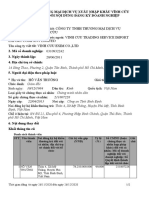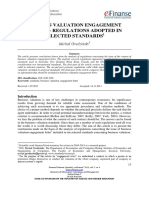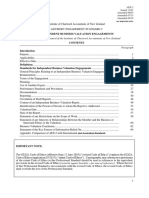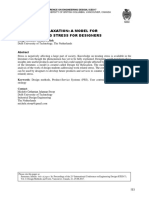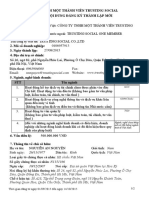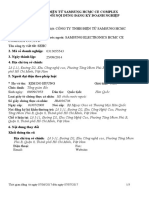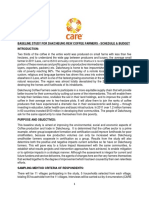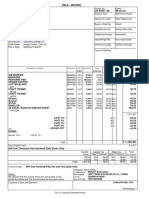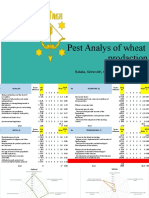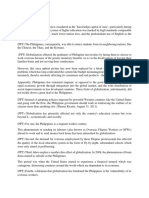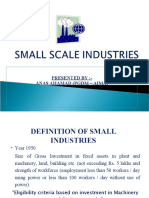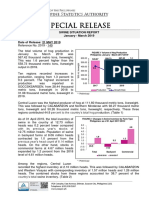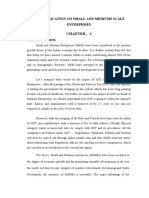Vietnam and The Global Value Chain: FIGURE 2.1. Export-Led Growth and Poverty Reduction, 1992-2017
Vietnam and The Global Value Chain: FIGURE 2.1. Export-Led Growth and Poverty Reduction, 1992-2017
Uploaded by
hnmjzhviCopyright:
Available Formats
Vietnam and The Global Value Chain: FIGURE 2.1. Export-Led Growth and Poverty Reduction, 1992-2017
Vietnam and The Global Value Chain: FIGURE 2.1. Export-Led Growth and Poverty Reduction, 1992-2017
Uploaded by
hnmjzhviOriginal Title
Copyright
Available Formats
Share this document
Did you find this document useful?
Is this content inappropriate?
Copyright:
Available Formats
Vietnam and The Global Value Chain: FIGURE 2.1. Export-Led Growth and Poverty Reduction, 1992-2017
Vietnam and The Global Value Chain: FIGURE 2.1. Export-Led Growth and Poverty Reduction, 1992-2017
Uploaded by
hnmjzhviCopyright:
Available Formats
Vietnam and the Global Value Chain 1
Global empirical evidence shows that trade promotes growth. Through increased competition,
trade reallocates resources toward more productive sectors and firms and boosts real incomes by
lowering prices for consumers and firms. And by supporting growth, trade openness can also be an
important driver of poverty reduction. During the period between 1960 and 1990, eight high-
performing Asian economies in terms of trade—Japan; Republic of Korea; Taiwan, China; Hong Kong
SAR, China; Singapore; Malaysia; Indonesia; and Thailand—had an average growth rate of 5.5 percent
per year, higher and more sustainable than any other groups of countries in the world (Birdsall and
others 1993). Vietnam is no exception. The export-led growth strategy and global integration
adopted in Vietnam have been key factors, among other things, for Vietnam’s remarkable
achievement over the last more than two-and-half decades in generating economic growth and
poverty reduction.
During the period from 1992 to 2017, Vietnam developed into one of the world’s most
open trading countries, with an export-to-GDP ratio of more than 100 percent in 2017.
Figure 2.1 shows the interlink between the trade (export to GDP ratio), the growth trend reflected by
GDP per capita, and the poverty reduction (headcount ratio at US$3.2 per day) for the period. As an
export power house, in the past ten years, Vietnam’s merchandise export growth averaged more
than 15 percent, almost five times the global growth. As a result of this remarkable trade
performance, Vietnam’s GDP per capita, measured by constant price in 2010, realized a nearly four-
fold increase during this period, from less than US$500 in 1992 to more than US$1,800 in 2017. The
poverty rate of Vietnam also decreased remarkably over the same timeframe—with the poverty line
threshold at US$3.20 a day, the poverty headcount as a percentage of Vietnam’s total population
decreased from nearly 52.9 percent in 1992 to 2.2 percent in 2017.
FIGURE 2.1. Export-Led Growth and Poverty Reduction, 1992–2017
2,500 100 2014 Poverty headcount (% of population)
2,000 80
GDP per capita (US$)
Export to GDP (%)
1,500 60
52.9
1,000 40
35.5 38
26.5
500 19.5 20
14.8
4.2 2.8 2
- -
AFT
2.7
-199
WTO
6
2000
-200
7
-201
7
2008
2016
A
BTA
-
PP
CPT
US
1992
1993
1994
1995
1997
1998
1999
2001
2002
2003
2004
2005
2006
2009
2010
2011
2012
2013
2015
GDP per capita (current US$) Poverty headcount (% of population)
Export to GDP (%) Log. (Poverty headcount (% of population))
Source: UNComtrade database, available at
https://comtrade.un.org/.
Chapter 2: Integrating with Global Markets 29
You might also like
- Genicon Case - International Marketing - Group 6Document10 pagesGenicon Case - International Marketing - Group 6Anandita JainNo ratings yet
- Budget Speech 2020-2021Document29 pagesBudget Speech 2020-2021IbrahimGorgageNo ratings yet
- World Economic IndicatorsDocument3 pagesWorld Economic IndicatorsSteveTillNo ratings yet
- Trends and Developments in Electric Vehicle Markets - Global EV Outlook 2021 - Analysis - IEA 3Document1 pageTrends and Developments in Electric Vehicle Markets - Global EV Outlook 2021 - Analysis - IEA 3SUJITH KUMAR SNo ratings yet
- Malaysia - Economic Trends: Gross Domestic ProductDocument5 pagesMalaysia - Economic Trends: Gross Domestic ProductyuiclynesNo ratings yet
- HKTDC MzU3OTAyNjA4 enDocument10 pagesHKTDC MzU3OTAyNjA4 enweiqin chenNo ratings yet
- Cold War II Preserving Economic Cooperation Amid Geoeconomic FragmentationDocument19 pagesCold War II Preserving Economic Cooperation Amid Geoeconomic FragmentationAmmadeus VegaNo ratings yet
- Business Strategy For The Petrochemicals & Plastics Sector: October 8, 2015Document36 pagesBusiness Strategy For The Petrochemicals & Plastics Sector: October 8, 2015afs araeNo ratings yet
- GWC AR2019 EnglishDocument63 pagesGWC AR2019 Englishmohammedali.belhediNo ratings yet
- Implication of Russia Ukraine Conflict On UAEDocument19 pagesImplication of Russia Ukraine Conflict On UAELerma Landaos100% (1)
- Retail Sales Survey March 2020Document8 pagesRetail Sales Survey March 2020ArtistabesttNo ratings yet
- Why North Macedonia - 2020 - Real Estate Market - Fortonmka Cushman & WakefieldDocument54 pagesWhy North Macedonia - 2020 - Real Estate Market - Fortonmka Cushman & Wakefieldana.filiposka124No ratings yet
- ProQuestDocuments 2024 05 09Document106 pagesProQuestDocuments 2024 05 09Vaishnavi ShringiNo ratings yet
- Deepblue 3.0: Technical White PaperDocument18 pagesDeepblue 3.0: Technical White PaperhamzaNo ratings yet
- Leyenda: Curv1SuavDocument1 pageLeyenda: Curv1SuavRodrigo FloresNo ratings yet
- Wesp2020 Summary enDocument21 pagesWesp2020 Summary enClaudium Claudius0% (1)
- India GDPDocument1 pageIndia GDPwitedruidNo ratings yet
- Response To PTI White Paper FinalDocument30 pagesResponse To PTI White Paper FinalKhawaja BurhanNo ratings yet
- Ekonomski Pregled OECD-aDocument26 pagesEkonomski Pregled OECD-aTportal.hrNo ratings yet
- ICCT Comments Renewable Fuel Standard Program Rvo Noda 20171019Document5 pagesICCT Comments Renewable Fuel Standard Program Rvo Noda 20171019The International Council on Clean TransportationNo ratings yet
- Abstract Global Manufacturing Market TrackerDocument2 pagesAbstract Global Manufacturing Market Trackerhailey LopezNo ratings yet
- 2 - Avendano - Digital Regulation Framework For ASEANDocument15 pages2 - Avendano - Digital Regulation Framework For ASEANAom SakornNo ratings yet
- Retail Industry - Mm6febDocument23 pagesRetail Industry - Mm6febdelin davidNo ratings yet
- Coalition Government - 1 Coalition 60Document35 pagesCoalition Government - 1 Coalition 60Anonymous qjccOiLn100% (2)
- Economic Survey 2023-24Document25 pagesEconomic Survey 2023-24Ayaz ZafarNo ratings yet
- Wipes in Brazil DatagraphicsDocument4 pagesWipes in Brazil DatagraphicsbabiNo ratings yet
- "Rapid Net Growth Continues in U.S." - by Bret Swanson - 03.05.09Document1 page"Rapid Net Growth Continues in U.S." - by Bret Swanson - 03.05.09Bret SwansonNo ratings yet
- Bangladesh Economic Growth FDIs - Lightcastle Partners PresentationDocument10 pagesBangladesh Economic Growth FDIs - Lightcastle Partners PresentationMizanur RahmanNo ratings yet
- Business Update 2019 PresentationDocument50 pagesBusiness Update 2019 Presentationlets playNo ratings yet
- Retail Sales Ina 2019Document7 pagesRetail Sales Ina 2019gege tantoroNo ratings yet
- 1Q2021 Fullbook enDocument48 pages1Q2021 Fullbook enVincentNo ratings yet
- FAST Maria Rua Aguete - pptxSENT-002.pptxpdf-1Document18 pagesFAST Maria Rua Aguete - pptxSENT-002.pptxpdf-1PLANET CELLULLOIDNo ratings yet
- 2a1093136 CKF PDFDocument96 pages2a1093136 CKF PDFdua tanveerNo ratings yet
- Asia Monthly Outlook July-2023Document19 pagesAsia Monthly Outlook July-2023Muhammad LuthfiNo ratings yet
- Guide To: ExcellenceDocument12 pagesGuide To: ExcellenceSuri SANo ratings yet
- The Role of The Service Sector in The EconomyDocument8 pagesThe Role of The Service Sector in The Economypankaj pandayNo ratings yet
- Patent Report Issue1Document4 pagesPatent Report Issue1Vorasilp KijchavengkulNo ratings yet
- Macroeconomic and Growth ChallengesDocument4 pagesMacroeconomic and Growth ChallengesRishit ChatterjeeNo ratings yet
- Malaysian House Price Index (MHPI)Document2 pagesMalaysian House Price Index (MHPI)Afiq KhidhirNo ratings yet
- GEM - Structure - Vietnam - AB 2021 10 19Document34 pagesGEM - Structure - Vietnam - AB 2021 10 19Trần Thái Đình KhươngNo ratings yet
- Superhouse Limited: StockDocument115 pagesSuperhouse Limited: StockMabood Ahmad AnsariNo ratings yet
- Screener - in TempleteDocument11 pagesScreener - in TempleteSumantha SahaNo ratings yet
- 乐鑫科技2021年企业社会责任报告Document48 pages乐鑫科技2021年企业社会责任报告王烁然No ratings yet
- S6 - Boyacioglu On WheatDocument46 pagesS6 - Boyacioglu On WheatLuki HardiyantiNo ratings yet
- Egypt Economic SurveyDocument27 pagesEgypt Economic SurveyAnshu AgarwalNo ratings yet
- Proposed Residential Apartments. 01Document2 pagesProposed Residential Apartments. 01Daniel OkereNo ratings yet
- 16 December 2020 ReportDocument40 pages16 December 2020 ReportCheah Chee MunNo ratings yet
- B&K - MFS Q4fy22Document8 pagesB&K - MFS Q4fy22Bhavna PanwarNo ratings yet
- Industry Outlook March2011Document4 pagesIndustry Outlook March2011iminvisibleNo ratings yet
- Country Profile: ColombiaDocument10 pagesCountry Profile: ColombiaPaula Andrea RodríguezNo ratings yet
- CS Offshore Wind PDFDocument49 pagesCS Offshore Wind PDFIshanGuptaNo ratings yet
- Usman Ashraf-85 PresentationDocument18 pagesUsman Ashraf-85 PresentationDopest KhanNo ratings yet
- 音速小子 Sonic the Hedgehog - Yahoo奇摩電影Document1 page音速小子 Sonic the Hedgehog - Yahoo奇摩電影葉澤麟No ratings yet
- Axiata Iar-Our PerformanceDocument20 pagesAxiata Iar-Our PerformanceYour CrushNo ratings yet
- v1 Panbio COVID-19 IgG IgM QRG OUSDocument1 pagev1 Panbio COVID-19 IgG IgM QRG OUSAchmad NurNo ratings yet
- Xing 1Document45 pagesXing 1tempguy7369No ratings yet
- R-20-01 FR Euro - Office - Belgrade PDFDocument5 pagesR-20-01 FR Euro - Office - Belgrade PDFvedadNo ratings yet
- Asia Monthly Outlook Apr-2023Document23 pagesAsia Monthly Outlook Apr-2023Muhammad LuthfiNo ratings yet
- Quiz 1Document6 pagesQuiz 1prathamesh rokdeNo ratings yet
- Economic Indicators for Southeast Asia and the Pacific: Input–Output TablesFrom EverandEconomic Indicators for Southeast Asia and the Pacific: Input–Output TablesNo ratings yet
- Economic Indicators for South and Central Asia: Input–Output TablesFrom EverandEconomic Indicators for South and Central Asia: Input–Output TablesNo ratings yet
- Draft Doa - CCMF - mt103 - Agreement 80-20Document17 pagesDraft Doa - CCMF - mt103 - Agreement 80-20hnmjzhvi100% (1)
- Modified Pyramid of CSR For Corporate Image and Customer Loyalty: Focusing On The Moderating Role of The CSR ExperienceDocument21 pagesModified Pyramid of CSR For Corporate Image and Customer Loyalty: Focusing On The Moderating Role of The CSR ExperiencehnmjzhviNo ratings yet
- ResultDocument3 pagesResulthnmjzhviNo ratings yet
- Tên Công Ty: %Ĉ QJ& (QJQJKL S.KX& (QJQJKL S6Jlĉ Qj%3K Qj7K̩Fk%Jq4X Q /Rqj%Lrq7Kjqksk +J1 L9L W1DpDocument3 pagesTên Công Ty: %Ĉ QJ& (QJQJKL S.KX& (QJQJKL S6Jlĉ Qj%3K Qj7K̩Fk%Jq4X Q /Rqj%Lrq7Kjqksk +J1 L9L W1Dphnmjzhvi100% (1)
- Tên Công Ty: Export Company LimitedDocument2 pagesTên Công Ty: Export Company LimitedhnmjzhviNo ratings yet
- Lot 1 PWC Statement of WorkDocument6 pagesLot 1 PWC Statement of WorkhnmjzhviNo ratings yet
- Vilaf Nguyen Phuong NganDocument1 pageVilaf Nguyen Phuong NganhnmjzhviNo ratings yet
- Limited: Công Ty TNHH Domasca Ihouzz LandDocument4 pagesLimited: Công Ty TNHH Domasca Ihouzz LandhnmjzhviNo ratings yet
- Free Trade Agreements: US$ 33.6 TrillionDocument1 pageFree Trade Agreements: US$ 33.6 TrillionhnmjzhviNo ratings yet
- NKF VA BrochureDocument20 pagesNKF VA BrochurehnmjzhviNo ratings yet
- Công Ty TNHH 3L Capital: 3Kzqj7̯Qj7Zdqkj9Lqfrp&Hqwhuĉ NG Lê 7kiqk7 (Q3K QJ% Q 1Jkp4X Q7Kjqksk + &Kt0Lqk9L W1DpDocument3 pagesCông Ty TNHH 3L Capital: 3Kzqj7̯Qj7Zdqkj9Lqfrp&Hqwhuĉ NG Lê 7kiqk7 (Q3K QJ% Q 1Jkp4X Q7Kjqksk + &Kt0Lqk9L W1DphnmjzhviNo ratings yet
- Sustainability: DrivingDocument71 pagesSustainability: DrivinghnmjzhviNo ratings yet
- Business Valuation Engagement Letter - Regulations Adopted in Selected StandardsDocument12 pagesBusiness Valuation Engagement Letter - Regulations Adopted in Selected StandardshnmjzhviNo ratings yet
- AES2 Indepependent Business Valuation EngagementsDocument10 pagesAES2 Indepependent Business Valuation EngagementshnmjzhviNo ratings yet
- DS87 Vol4 DesMet 458Document10 pagesDS87 Vol4 DesMet 458hnmjzhviNo ratings yet
- FIGURE 2.2. Structural Change in Technology Embodied in Export, 1997-2017Document1 pageFIGURE 2.2. Structural Change in Technology Embodied in Export, 1997-2017hnmjzhviNo ratings yet
- Tên Công Ty: CorporationDocument2 pagesTên Công Ty: CorporationhnmjzhviNo ratings yet
- Công Ty TNHH Trusting Social: 7̯Qj7Zdqkj+Dydqd+Jp1Jkl3K QJ% Q7Kjqk4X Q7Kjqksk + &Kt0Lqk9L W1DpDocument5 pagesCông Ty TNHH Trusting Social: 7̯Qj7Zdqkj+Dydqd+Jp1Jkl3K QJ% Q7Kjqk4X Q7Kjqksk + &Kt0Lqk9L W1DphnmjzhviNo ratings yet
- Social Company Limited: 1. Tên Công TyDocument2 pagesSocial Company Limited: 1. Tên Công TyhnmjzhviNo ratings yet
- Tên Công Ty: LimitedDocument2 pagesTên Công Ty: LimitedhnmjzhviNo ratings yet
- Sài Gòn: 1. Tên Công TyDocument2 pagesSài Gòn: 1. Tên Công TyhnmjzhviNo ratings yet
- Ce Complex: 1. Tên Công TyDocument3 pagesCe Complex: 1. Tên Công TyhnmjzhviNo ratings yet
- Sài Gòn: 1. Tên Công TyDocument2 pagesSài Gòn: 1. Tên Công TyhnmjzhviNo ratings yet
- Ce Complex: 1. Tên Công TyDocument2 pagesCe Complex: 1. Tên Công TyhnmjzhviNo ratings yet
- Role of Agriculture in Economic DevelopmentDocument27 pagesRole of Agriculture in Economic DevelopmentSyed Khurram Ali100% (1)
- List of Companies ICAIDocument2 pagesList of Companies ICAIAnurag SingalNo ratings yet
- Baseline Study For Dakcheung Rew Coffee FarmersDocument2 pagesBaseline Study For Dakcheung Rew Coffee FarmersCANADIAN INSTITUTE OF TOURISM AND SUSTAINABLE LIVELIHOODS - CITSL- Brian TourayNo ratings yet
- Aditya Techno Fab EngineeringDocument1 pageAditya Techno Fab Engineeringdherendra chhadodiNo ratings yet
- Pest Analys of Wheat Prodaction: Balaka, Grinevich, Orlo, Khilkovets, ChernyshovaDocument3 pagesPest Analys of Wheat Prodaction: Balaka, Grinevich, Orlo, Khilkovets, ChernyshovaБогдан БалакаNo ratings yet
- Globalization in PhilippinesDocument4 pagesGlobalization in PhilippinesHamida Ismael MacabantogNo ratings yet
- Bank PDFDocument24 pagesBank PDFDeepak RajeNo ratings yet
- CC Famebalaji STMNT (146339)Document81 pagesCC Famebalaji STMNT (146339)Subramanyam JonnaNo ratings yet
- ECON 04310 Midterm II (MCQ) Study GuideDocument4 pagesECON 04310 Midterm II (MCQ) Study GuideMichael Joseph WebsterNo ratings yet
- Assignment 2 MIS 207 1612631030Document6 pagesAssignment 2 MIS 207 1612631030shamim islam limonNo ratings yet
- US China Trade War Impact On IndiaDocument6 pagesUS China Trade War Impact On IndiaAryan MaheshwariNo ratings yet
- Small Scale Industries by Anas AhamadDocument17 pagesSmall Scale Industries by Anas AhamadMd Anas Ahmed AnasNo ratings yet
- Vol18Sabah Section2Document38 pagesVol18Sabah Section2Naziemi AhmadNo ratings yet
- STC Presentation Q1 2022 NEWDocument46 pagesSTC Presentation Q1 2022 NEWGhadaNo ratings yet
- No12 Wuxi Huada MotorsDocument2 pagesNo12 Wuxi Huada MotorsalishahsavarNo ratings yet
- Socio Economic GrowthDocument3 pagesSocio Economic GrowthniteshNo ratings yet
- Fin542 Individual AssDocument8 pagesFin542 Individual AssImran AziziNo ratings yet
- Special Release: Philippine Statistics AuthorityDocument6 pagesSpecial Release: Philippine Statistics AuthoritySamael LightbringerNo ratings yet
- Banking Operation PPT PresentationDocument15 pagesBanking Operation PPT PresentationSomnathNo ratings yet
- Position PaperDocument2 pagesPosition PaperSweet MarimarNo ratings yet
- HIC, MIC, LIC Study PowerpointDocument9 pagesHIC, MIC, LIC Study PowerpointAyala ErezNo ratings yet
- Small and Medium EnterprisesDocument6 pagesSmall and Medium EnterprisesSarva ShivaNo ratings yet
- FDI and Trade BalanceDocument5 pagesFDI and Trade BalanceCharlyn Jewel OlaesNo ratings yet
- Australian Economy and Its PoliciesDocument2 pagesAustralian Economy and Its PoliciesAdvaith IlavajhalaNo ratings yet
- Icra MacroDocument3 pagesIcra MacroSunayan PalNo ratings yet
- Session 4 Chapter 3 Mode of EntryDocument32 pagesSession 4 Chapter 3 Mode of EntryApurva RamtekeNo ratings yet
- 4 Major Sectors of An Economy: 1. Household SectorDocument3 pages4 Major Sectors of An Economy: 1. Household SectorMartha EeluNo ratings yet
- Unit 3 Balance of Payment: Sanjay GhimireDocument27 pagesUnit 3 Balance of Payment: Sanjay GhimireSabin ShresthaNo ratings yet
- Model Pengawasan Penggunaan Pinjaman Luar Negeri: Studi World Bank Dan IMF Di IndonesiaDocument18 pagesModel Pengawasan Penggunaan Pinjaman Luar Negeri: Studi World Bank Dan IMF Di IndonesiaMuhammad Fiqri MajitNo ratings yet

